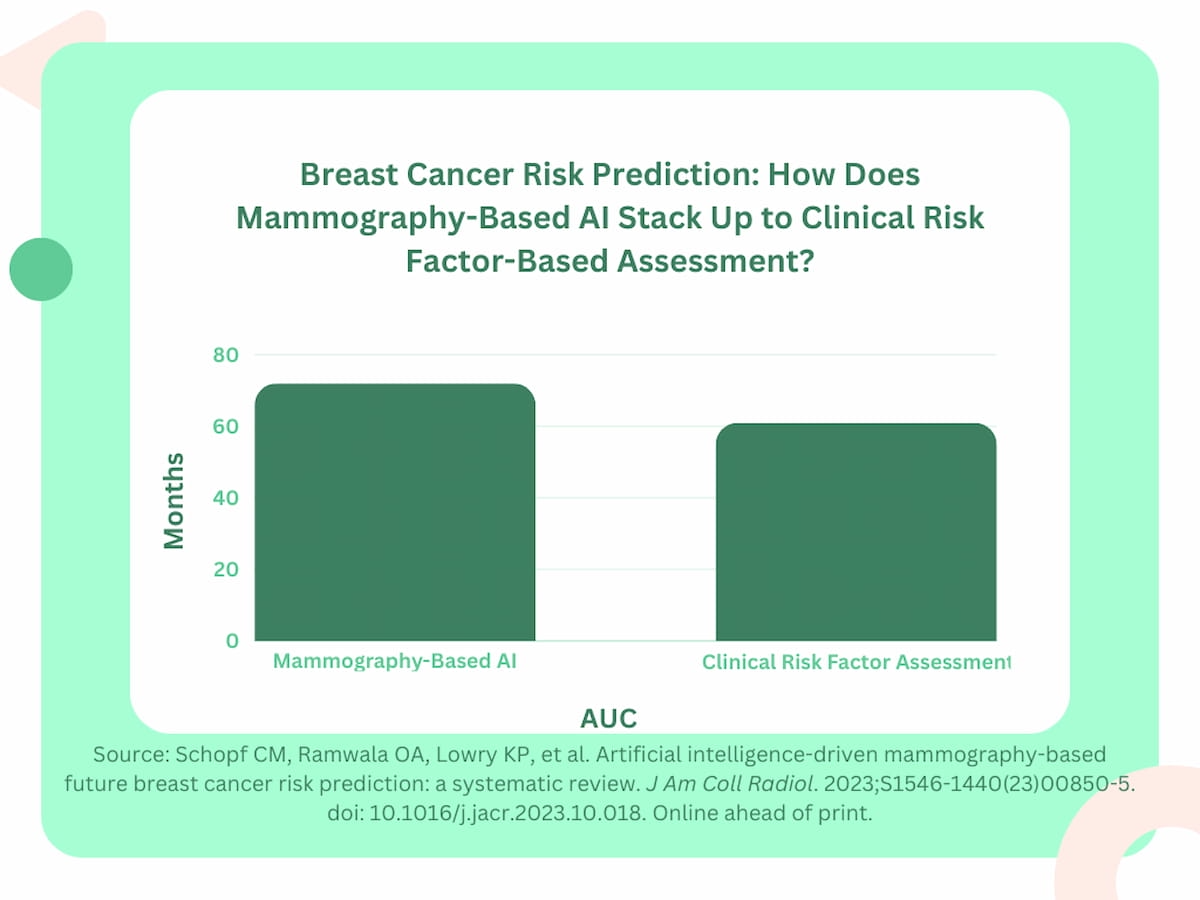Can mammography-based artificial intelligence (AI) modalities enhance breast cancer risk assessment?
In a new systematic literature review, recently published in the Journal of the American College of Radiology, researchers reviewed data from 16 retrospective studies evaluating the use of AI algorithms to predict breast cancer. The reviewed AI algorithms were based on screening mammography images alone or on a combination of mammography imaging and clinical risk factors, according to the review.
The researchers found that the AI image-only models had a 72 percent median area under the receiver operating characteristic curve (AUC) for predicting breast cancer in comparison to a median AUC of 61 percent for breast cancer prediction based upon breast density or clinical risk factor-based tools.
“Our systematic review demonstrates that early AI efforts for predicting future breast cancer risk based on mammography images alone may provide comparable or better accuracy to risk based on breast density or traditional clinical risk-factor-based measures being used today,” wrote study co-author Christoph Lee, M.D., M.S., a professor of radiology at the University of Washington School of Medicine and adjunct professor of Health Systems and Population Health at the University of Washington School of Public Health, and colleagues.
Seven of the reviewed studies examined AI tools that combined mammography imaging assessment with clinical risk factors, according to the study authors. The researchers noted a median AUC of 73 percent for these modalities and that six of the studies revealed no significant improvement in predicting breast cancer between these combination models and AI models based on imaging alone.
“If subjective self-reported traditional clinical risk factors do not provide substantial incremental improvements to risk prediction, then their collection may not be needed,” suggested Lee and colleagues. “This could eliminate much of the effort and human subjectivity that contribute to the current traditional clinical factor-based risk prediction practices performed at the time of screening mammography or in primary care clinics. If not used as standalone risk assessment tools, AI image-based risk prediction may provide complementary information to risk prediction based on traditional clinical risk factors.”
Three Key Takeaways
- AI-based mammography shows comparable or improved accuracy to breast cancer risk assessment with clinical risk factors. The systematic literature review suggests that early AI models using mammography images alone for breast cancer prediction demonstrate a median area under the receiver operating characteristic curve (AUC) of 72 percent, which is comparable or superior to the median AUC of 61 percent obtained using breast density or traditional clinical risk factors. This indicates the potential of AI-based modalities to enhance the accuracy of breast cancer risk assessment compared to current methods.
- Limited incremental benefit of adding clinical risk factors to AI imaging assessment. The study indicates that combining AI assessments of mammography images with traditional clinical risk factors does not significantly improve breast cancer prediction over AI models based on imaging alone. This finding suggests that the collection of subjective self-reported traditional clinical risk factors may not be necessary, potentially streamlining risk assessment efforts and reducing human subjectivity in current practices.
- Health equity implications. The review highlights that AI models demonstrated similar accuracy in predicting breast cancer across different racial and ethnic groups, with some evidence suggesting significantly enhanced risk assessment for non-White women compared to clinical risk factors. However, the authors emphasize the need for future studies with larger and more diverse populations, as conflicting results have been reported across studies considering patients of different races, ethnicities, and menopausal statuses. The call for prospective study designs and more extensive, diverse datasets aims to ensure the generalizability of AI-based risk assessments across diverse populations.
Lee and colleagues also noted that five of the reviewed studies compared the accuracy of the AI models between White and non-White patients. Not only did the AI models show similar accuracy in predicting breast cancer in all of the study groups, the study authors pointed out that three studies demonstrated that AI models offered significantly enhanced breast cancer risk assessment for non-White women in contrast to clinical risk factors. However, the authors cautioned that other studies have shown conflicting results when assessing AI algorithms across patients of different races, and ethnicities and menopausal status.
“Thus, future studies should include prospective study designs and include larger, more diverse screening populations with robust long-term follow-up data for more generalizable results,” added Lee and colleagues.
(Editor’s note: For related content, see “Mammography Study: AI Software Predicts One-Third of Breast Cancer Cases Up to Two Years Prior to Diagnosis,” “Mammography-Based Deep Learning Model Facilitates Higher Breast Cancer Detection on Screening MRI” and “Combining AI Lesion Detection, Mammographic Texture Model Improves Breast Cancer Risk Assessment.”)
In regard to limitations of the systematic review, the authors acknowledged the review was limited to studies published in English. They also conceded that small minority populations within study cohorts limited comparisons of AI model predictive accuracy between White and non-White patients. Lee and colleagues also noted that the impact of the AI models on breast cancer detection and workflow efficiencies was beyond the scope of this systematic review.











